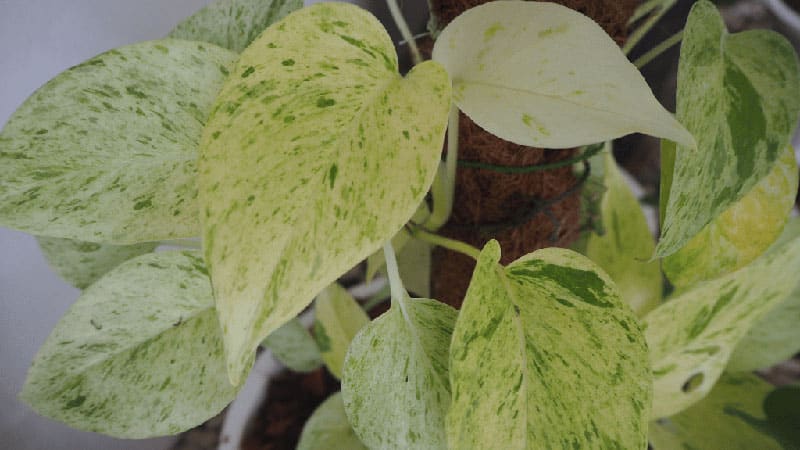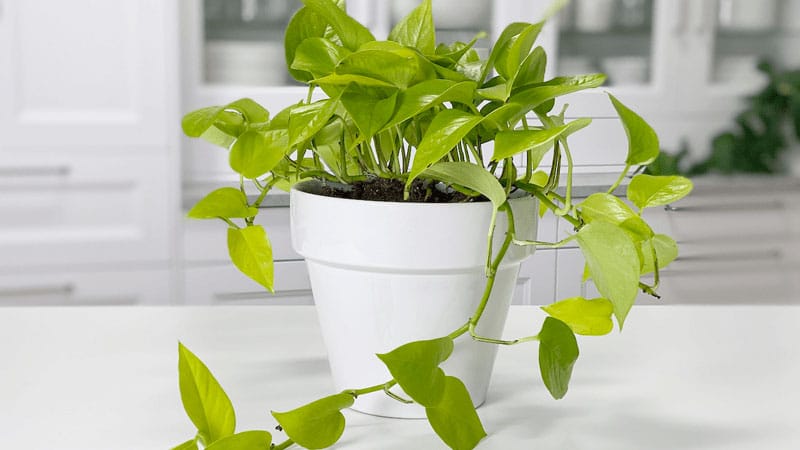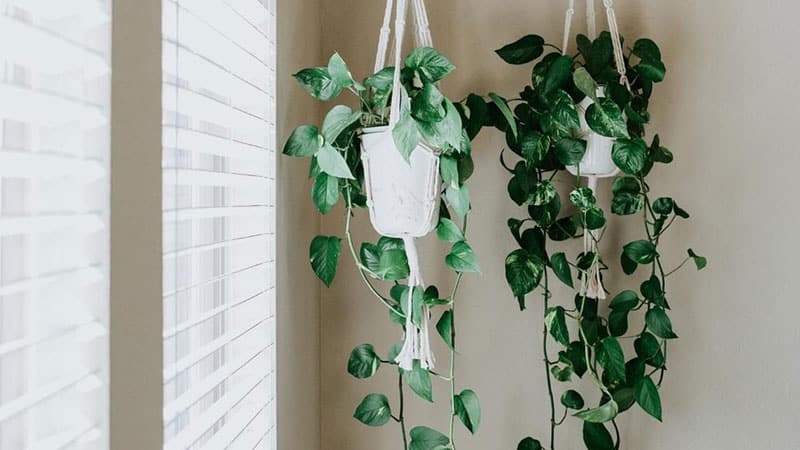Whether you’re a seasoned plant enthusiast or a budding indoor gardener, understanding the Pothos Light Requirements is pivotal to the thriving success of your plant. In this comprehensive guide, we embark on an enlightening journey into this resilient plant’s specific light requirements for optimal growth and vibrancy. From deciphering the nuances of natural sunlight to mastering the art of artificial lighting, join us as we illuminate the path to cultivating a thriving Pothos haven in your home. Get ready to explore the radiant secrets that will transform your Pothos into a beacon of botanical brilliance.
The Significance of Light for Pothos
Pothos, scientifically known as Epipremnum aureum, originate from the lush tropical forests of Southeast Asia, the Pacific islands, and Australia, where they flourish beneath the intricate canopy of taller trees, basking in the gentle, filtered sunlight. Their natural habitat has equipped them with the remarkable ability to adapt to varying light conditions, thriving in both medium and low-light environments.

When brought into indoor settings, Pothos plants must carefully consider their lighting requirements. While they boast resilience to moderate and dim light in their native surroundings, providing them with an adequate amount of light for photosynthesis when cultivated indoors is imperative. This process is vital for the plants to manufacture the energy essential for their growth and well-being.
Insufficient light exposure indoors can lead to the undesirable development of leggy and feeble Pothos specimens. In extreme cases, their growth may even come to a halt. On the other hand, excessive direct sunlight can be detrimental, causing the leaves to scorch and compromising the plant’s health. Striking an optimal balance between lower and higher light levels is vital to nurturing thriving Pothos plants within a household environment.
What amount of sunlight is required by Pothos?
Pothos plants thrive when exposed to bright, indirect light. This implies finding an ideal location near a window with ample brightness but shielded from direct sunlight. Alternatively, a window receiving direct morning light for 3-4 hours daily can suffice, provided it is not subjected to intense afternoon sunlight unless protected by blinds or a sheer curtain. Striving for 12-14 hours of indirect light daily is optimal.

Insufficient light can prompt a Pothos plant to stretch towards the nearest light source, resulting in a leggy and weakened appearance and even causing the plant to tip over. Varied Pothos varieties may have distinct light requirements; for instance, variegated types require brighter light to achieve their full-color potential. All-green varieties like Neon, Global Green, and Baltic Blue can efficiently photosynthesize and tolerate lower-light conditions.
Direct and Indirect Light for Potho’s needs
Direct Light
Direct light refers to sunlight that directly strikes a plant, and it can be overly intense for numerous plant species, leading to potential harm such as leaf damage, discoloration, and overall stress. This type of sunlight is most suitable for plants that naturally flourish in hot and sunny climates, such as cacti and succulents, which have evolved to thrive under the harsh conditions of direct sunlight.

Indirect Light
Indirect light refers to sunlight that doesn’t directly contact the plant, typically filtering through a window or other covering. This type of sunlight is gentler than direct light. It is generally considered more suitable for the well-being of most houseplants.
For plants that thrive in indirect light, it is advisable to position them near windows rather than directly in front. This strategic placement allows the plants to absorb the beneficial sunlight while minimizing the risk of sunburn. Orienting them to the side of windows ensures they receive the desired indirect light, striking a balance between illumination and protection.
How to recognize inadequate lighting for your Pothos
Six signs of insufficient Sunlight
Leggy Growth
Insufficient light triggers a response in Pothos plants, prompting them to elongate their stems to seek sunlight. This response manifests as the development of lengthy, slender stems accompanied by leaves noticeably spaced farther apart.

The observable characteristics of longer stems, increased internode spacing, and an overall stretched-out appearance indicate that the Pothos plant is not receiving enough light for optimal growth and health.
Small Leaves
When a Pothos plant lacks sufficient light, it faces a shortage of the energy and resources essential for properly developing fully-sized foliage. In essence, the plant cannot fulfill its growth potential, and the compromised size of its foliage becomes a tangible manifestation of the limitations imposed by the insufficient light supply.
Diminishment of leaf variegation
Inadequate exposure to sunlight can result in the loss of variegation in plant leaves. Specifically, golden Pothos tends to lose its vibrant golden variegation and shifts towards a predominantly green appearance in an attempt to adapt to low-light conditions. This transformation can disappoint individuals who chose the plant for its appealing coloring.
It’s important to note that the chloroplasts, the cellular structures responsible for most of a plant’s photosynthesis, are concentrated in the green parts of the leaves. When light is insufficient, the plant undergoes genetic alterations to conserve energy, ceasing the production of the golden or white segments of the leaves. This adaptive response reflects the plant’s prioritization of survival over ornamental features in the face of limited sunlight.
Soil Remaining Damp for Weeks
Pothos plants require well-drained potting soil and consistent watering to maintain their health and support growth. When a Pothos is exposed to limited light, water evaporation slows down, causing the soil to remain damp for extended periods, sometimes weeks.

This prolonged dampness becomes a breeding ground for issues like root rot, as the excess moisture creates unfavorable conditions for the roots, compromising their health and potentially harming the overall well-being of the plant.
Slow Growth
A gradual growth rate in your plant may be attributed to suboptimal lighting conditions. Plants undergo photosynthesis, a process crucial for their growth, wherein they produce their food utilizing sunlight, carbon dioxide, water, and minerals. Suppose any of these essential factors are insufficient or missing. In that case, the plant encounters challenges in effectively using photosynthesis and generating new foliage. In the context of lower light conditions, the limited availability of sunlight becomes a key factor hindering the plant’s ability to synthesize food and, consequently, stunting its growth.
Pale stems
Pale stems are an additional indication of insufficient light for your plant. The production of chlorophyll, essential for the plant’s green pigmentation, depends on adequate light. Consequently, pale stems signify a decline in chlorophyll synthesis due to the lack of proper lighting conditions. This affects the plant’s aesthetic appeal and serves as a clear visual cue of its struggle to receive the necessary sunlight for healthy growth.
How to solve
Fortunately, recognizing indications that your Pothos plant is experiencing insufficient light is the first step toward resolution. To address this issue effectively, consider relocating your plant to a more suitable spot, either closer to a window or an artificial light source. Additionally, ensure that your Pothos is positioned in an area that receives adequate light hours each day, even if the light intensity is deemed appropriate. These adjustments can rejuvenate your Pothos and provide the essential lighting conditions for sustained health and growth.
How to recognize excessive light for your Pothos
Two signs of too much Sunlight
Yellow or Brown Leaves Due to Sunburn
Subjecting your plant to a window with intense, direct sunlight will inevitably result in leaf burn. Sunburn manifests as brown or crispy lesions on the leaves, often accompanied by yellowing near the veins, which can progress to the point where leaf sections wither and die. Another unmistakable indication of excessive light exposure is an overall lightening of the foliage. In contrast to the paler green effect caused by low light conditions, sunburn imparts a washed-out, light yellow appearance that conveys an unhealthy and distressed look.

Washed-Out Variegation
Excessive exposure to direct sunlight causes the variegated sections of the leaves to lose their vibrancy and contrast, resulting in an unappealing “washed-out” appearance. The elegant striping or speckling characteristic of healthy plants fades, and the variegated portions take on an unattractive pale yellow or white shade.
How to solve
To address sunburn in plants, the initial step is to carefully trim away any affected leaves, particularly those with more than 50% damage. Since sunburnt leaves cannot repair themselves, removing them is typically the most effective approach. It is crucial to use sterile snipping tools during this process to minimize the risk of introducing pathogens into the cut portions of the plant.
After removing the affected leaves, relocate the plant to a more suitable location where it won’t be exposed to excessive light. Additionally, ensure to thoroughly water the plant if the soil is dry, offering a restorative measure to counterbalance any moisture loss caused by the sunburn. This combination of meticulous trimming and strategic relocation can aid in the plant’s recovery and prevent further damage.
How much light does pothos need
To optimize the growth of your Pothos, seek an indoor location that provides bright, indirect light ranging between 10,000 and 20,000 lux. The amount of lux in a room can be measured using a light meter, readily available as a standalone device or as a downloadable app for your smartphone.

The hand shadow technique provides an alternative method to assess the light intensity reaching your Pothos. To conduct this test, position your hand approximately one foot (12 inches or 30 cm) directly above a sheet of white paper and observe the shadow cast by your hand in the room’s natural light.
If you observe a precise and well-defined outline on the sheet, the area is abundantly illuminated and deemed ideal for your Pothos. A clear shadow suggests optimal light conditions. If the shadow is somewhat hazy or faint but still recognizable as a hand, the area receives moderate light, indicating conditions suitable for your Pothos, though not ideal. On the other hand, if there is no discernible shadow, it signifies low lighting, which may not provide sufficient illumination for the optimal growth of your Pothos.
Selecting the Location in Your Home to meet Pothos Light Requirements
Position this plant near a window that receives ample natural light for optimal growth. Pothos plants thrive in environments abundant in natural light, emphasizing brightness and indirect exposure.
Opt for rooms with generous windows, but exercise caution by avoiding direct placement of the pothos plant beside the window. Golden Pothos particularly benefits from being situated on bookshelves, suspended from the center of the room, or allowed to trail along the periphery. This strategic placement enables the plant to capture sunlight effectively without being subjected to the harsh intensity of direct rays.

Let’s examine the various windows in a home to determine the optimal location for meeting the light requirements of a Pothos plant:
- North-facing windows: These windows, lacking direct sunlight, serve as a suitable location for a Pothos plant. The plant can be hung on or near these windows without the risk of sunburn, thriving in filtered, indirect light.
- East-facing windows: Ideal for a Pothos plant, as they receive some direct sunlight in the morning. Throughout the day, the plant benefits from bright, indirect sunlight, making east-facing windows a favorable location.
- South-facing windows: While these windows provide consistent light, it is advisable to maintain the Pothos plant a few feet away from the window. This prevents direct exposure to intense sunlight, ensuring the plant receives bright, indirect light for optimal growth.
- West-facing windows: There are more suitable locations for a Pothos plant. West-facing windows receive strong direct sunlight in the afternoon, posing a risk of sunburn. To avoid excessive sunlight exposure, position the plant away from these windows, opting for a location that provides filtered, indirect light.
Enhancing Pothos Lighting Requirements with Artificial Light
If you suspect your Pothos is not receiving sufficient natural light from windows, supplementing it with artificial light becomes crucial for ensuring optimal conditions for healthy growth and development. Among the various artificial lighting options, metal halide lights are an excellent choice for plants. These lights provide a comprehensive spectrum of illumination closely resembling natural daylight, making them ideal for limited natural light periods.

Alternatively, a white spectrum LED grow light can be suitable for Pothos. It’s advisable to check the manufacturer’s specifications to ensure compatibility with pothos plants. Grow lights come in diverse styles and types, catering to the specific light requirements of plants like Pothos, promoting their growth and vitality.
When utilizing grow lights, it is essential to adhere to the manufacturer’s instructions regarding placement and duration of use to prevent overexposure or insufficient exposure of your Pothos to light. While fluorescent lighting in homes or offices is not the most favorable for Pothos, the plants can survive, especially when supplemented with some natural light. In an indoor setting, Pothos may remain smaller compared to their outdoor counterparts, with leaves typically reaching twelve to eighteen inches. Nevertheless, this size difference does not compromise the plant’s natural vibrant green color and appealing glossy finish.
Note: Adhering to the recommended spacing guidelines for the grow light is crucial. Incorrect spacing, whether excessive or insufficient, can result in potential issues affecting the health and growth of your plants.
Final Thoughts
In the radiant world of Pothos, where light intertwines with lush greenery, our exploration of its light needs and care guide comes to a close. As we’ve delved into the nuanced dance between natural and artificial light, it becomes evident that providing the right luminous environment is the key to unlocking the full potential of your Pothos. Armed with insights into the plant’s preferences, may your indoor garden flourish with vibrant, thriving Pothos specimens. Remember, in the art of cultivation, the thoughtful orchestration of light transforms these plants into verdant marvels. Happy gardening, and may your Pothos bask in the glow of a well-illuminated home!

